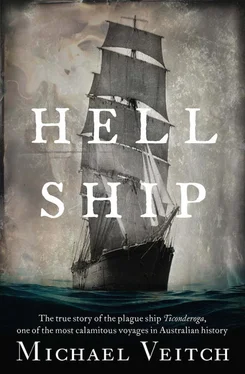Annie Morrison remained steadfast to the task she had undertaken since the early days of the epidemic, continuing to assist in the care, and now recovery, of the sick. In the many weeks since Dr Veitch’s desperate call for volunteers, Annie had long since exceeded all expectations. As she grew from the role of assistant to something far more important, he had come increasingly to appreciate her knowledge of each patient and their continually changing condition. Steadily, he came to rely not only on her tireless dedication but on her quietly soothing presence.
The recovering passengers were not quite as alone as they had first supposed. From the beach, excellent views were to be had of the many ships that daily passed back and forth, heading either out of the Rip or entering the bay and travelling up to Melbourne, a city still being inundated with people in search of gold. The passengers watched the busy pilots—the same ones who had guided them over to the cove—going about their daily business of leading bigger ships, full of cargo and hopeful passengers, through the difficult Heads and into the lanes. As the weeks of incarceration went by, many wished they too could be on board one of those ships and escape the monotony of their closed beach settlement, but close as they were in yards, they may as well have been a thousand miles distant.
Nor was the newly opened—albeit still rudimentary—quarantine station the exclusive preserve of those from the Ticonderoga . Although it would not be officially gazetted until the following year, nor fully completed with permanent buildings until 1855, Point Nepean was now very much in use, and other ships flying the yellow flag also began to drop anchor in the cove. None, however, presented a case as serious as the Ticonderoga , and most lingered only a few days or a week, their passengers strictly confined to their ship, before once again departing.
In the second week of December, Thomas Hunt returned to take up residence on the Lysander . From here, he could direct the progress of the construction of the station proper, which was slowly getting under way, as well as inspect the state of the Ticonderoga ’s passengers. It is presumed, too, that he had quietly lost faith in his appointee, Dr Taylor, and wished to keep a closer eye on him before his replacement could be organised.
A few days later, on 12 December, the camp became abuzz with the news that Governor La Trobe himself would be making a personal visit, and staying overnight in one of the staterooms of the Lysander —presumably situated a safe distance from the suffering and dying typhus patients in the ship’s hospital ward. Late that afternoon, the government schooner, HM Boomerang , glided into view and tied up alongside the great hulk of the Lysander . At a time when such persons were the true celebrities of the day, from the beach the passengers strained to secure as best a view as they could of His Excellency, some catching a glimpse of his slim blue uniformed figure as it made its way from the smaller vessel to the larger one.
It was at dinner on board the Lysander that evening that La Trobe, perhaps a little too carried away in the moment, and without consulting his own Chief Health Officer, Dr Hunt, made the offer to Dr Taylor of continuing to run the quarantine station a permanent one, in front of a no doubt astonished and possibly furious Hunt, who rescinded the appointment soon afterwards in any case. To Taylor’s deep and justified dismay, His Excellency, it seems, was happy to let the contradiction of his directive stand.
Christopher McRae and his friend were probably not the only ones to escape the beach camp, evade the guarding constables on the boundary line and make their own way north, but details are sketchy. Donald McDonald recalled, in a January 1917 edition of The Argus , that some restless passengers, ‘hearing the continued call of the siren of Bendigo and Fiery Creek, bolted like Buckley of an earlier time, and made the toilsome circuit of the eastern shore’.
It is from McDonald also that we learn that some may have even found some romance to pass the time. The lime-burners, evicted to the boundaries of the station, were nevertheless suddenly in the proximity of a large amount of single females, and those who were healthy had a good deal of time on their hands. As McDonald somewhat eloquently put it in his article:
These gallants of the lime pits saw few women, and amongst the ‘souls’ of the Ticonderoga were spinsters still comely, others hardy, if not handsome. So the lime-burners broke bounds upon one side, and the maidens upon the other. Once again, love laughed at locksmiths and quarantine became a name.
Some, at least, made the attempt to engage in more cerebral pastimes, such as Charles McKay, who had travelled with his wife Margaret and their five children to take up a role as head of the prestigious Scotch College, and who had performed the role of schoolmaster on board the Ticonderoga. It appears that he made attempts to establish something similar on shore, seeking the help of the person who had performed the same role in the women’s quarters, Isabella Renshaw. It seems to have not been a success, however, mainly due to Miss Renshaw herself becoming sick with fever during her time in quarantine.
As McKay would have realised, many of the faces to whom he had taught a few of the basics of reading and writing on the ship in the earlier stages of the voyage—as well as empowering some of them to sign their name for the first time—were now gone. He was aware, too, of his good fortune in that none of his family had caught the awful fever, and perhaps was civic-minded enough to wish to continue to give back to the small, deeply scarred community of which he was now a part. For his tireless efforts, both on the ship and on shore, McKay was eventually awarded the princely sum of £5.
Miss Renshaw was not nearly so lucky. Having been voted by the single girls with whom she travelled to be their matron and guardian, then having watched over them as they mixed with the other passengers on those risqué evenings spent on the warm deck as they passed over the equator, delighting all with their sweet voices singing the beautiful songs of the Highlands and feet moving swiftly in country dancing, and then having seen them fall, one by one, to the dreaded and unstoppable disease, cooling their brows and soothing them with words, Isabella Renshaw, 38, herself died at the quarantine station on 18 November.
In front of them, still anchored where she had disgorged her human cargo weeks before, lay the Ticonderoga , still a beautiful ship, now emptied of her passengers and thoroughly cleaned inside and out with limewater and whitewash. She would not stay empty for long.
On 19 December, Dr Hunt, who had spent the last few days satisfying himself that the crisis was abating, gave the all-clear for the Ticonderoga to leave and complete the final stage of her long journey from Birkenhead to Port Phillip. Some passengers, though, now employed by the government in quarantine, were more than happy with their lot and elected to stay on at the cove, which would become known as Ticonderoga Bay as the station became established.
In her extensive research, Mary Kruithof has discovered the identities of those who remained behind as their fellow passengers departed. [1] Kruithof, 2002, p. 83
James Swan, having travelled from Ayrshire with his wife Margaret and four-year-old son, and who was employed as one of the first of the station cooks, felt he had landed himself an excellent position. Some of the stonemasons—Robert Taylor, Alexander Gardiner and Henry Goodrich—likewise thought the terms of 6 shillings a day offered by Captain Ferguson to start building the station’s first structures agreeable, and decided to remain there.
Читать дальше












